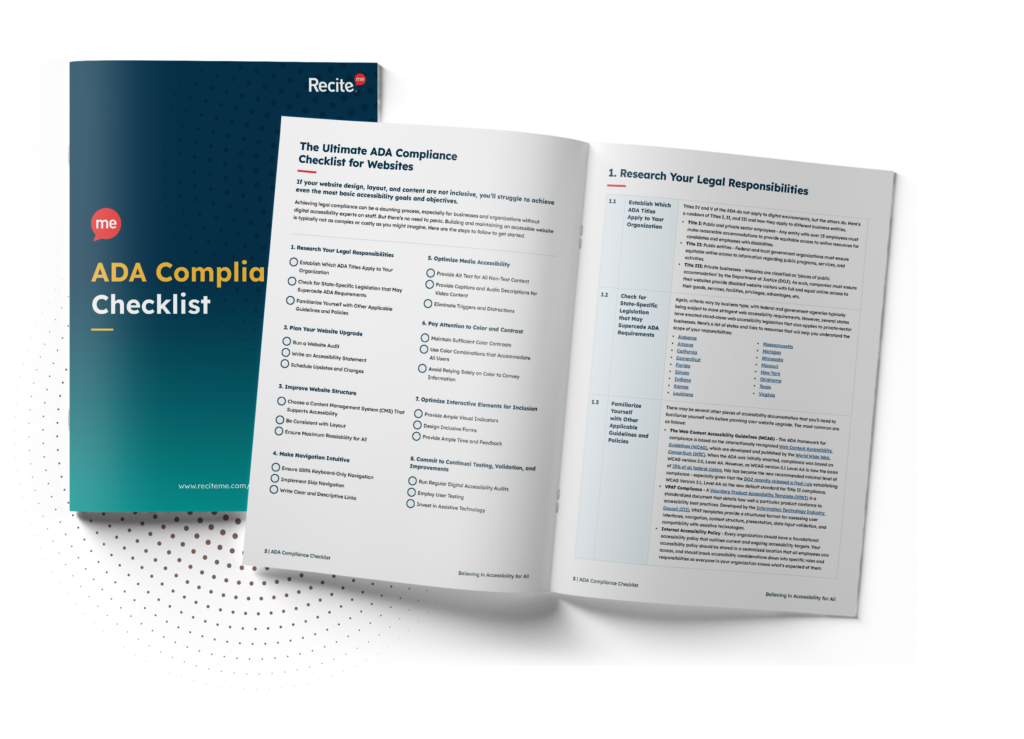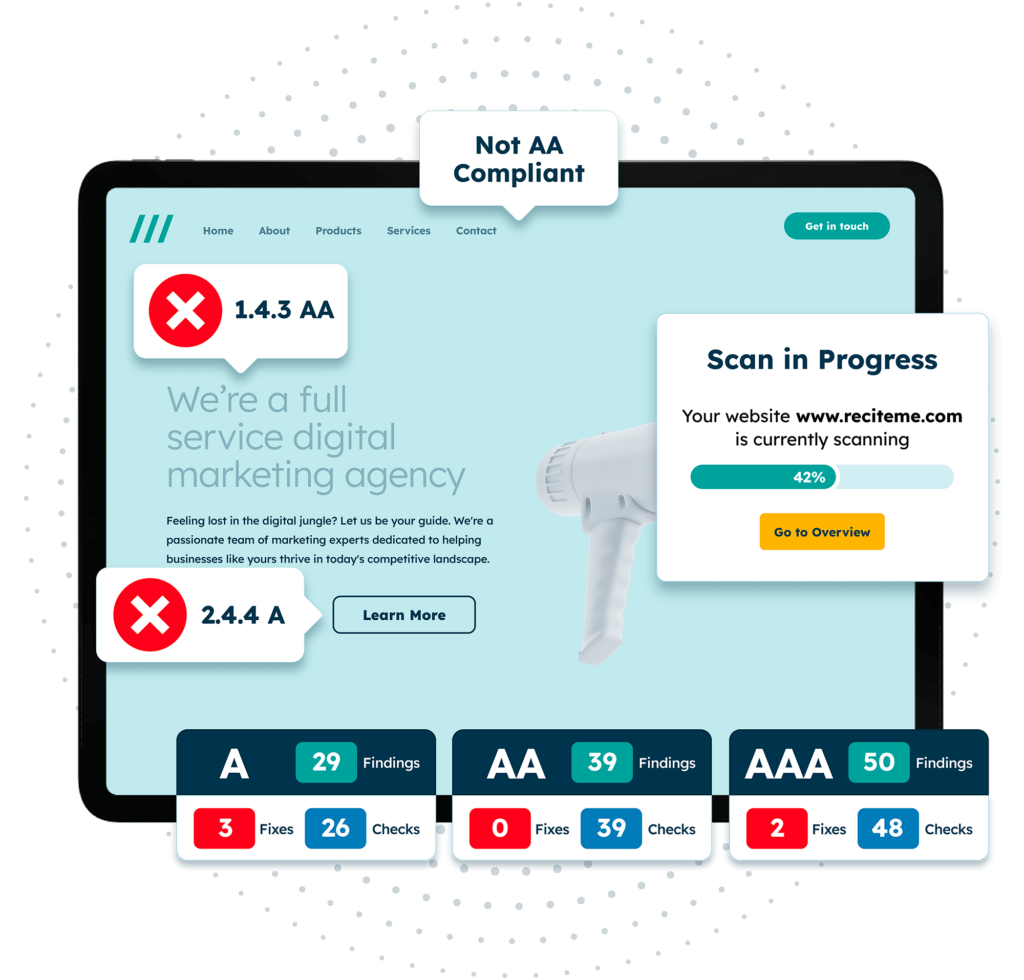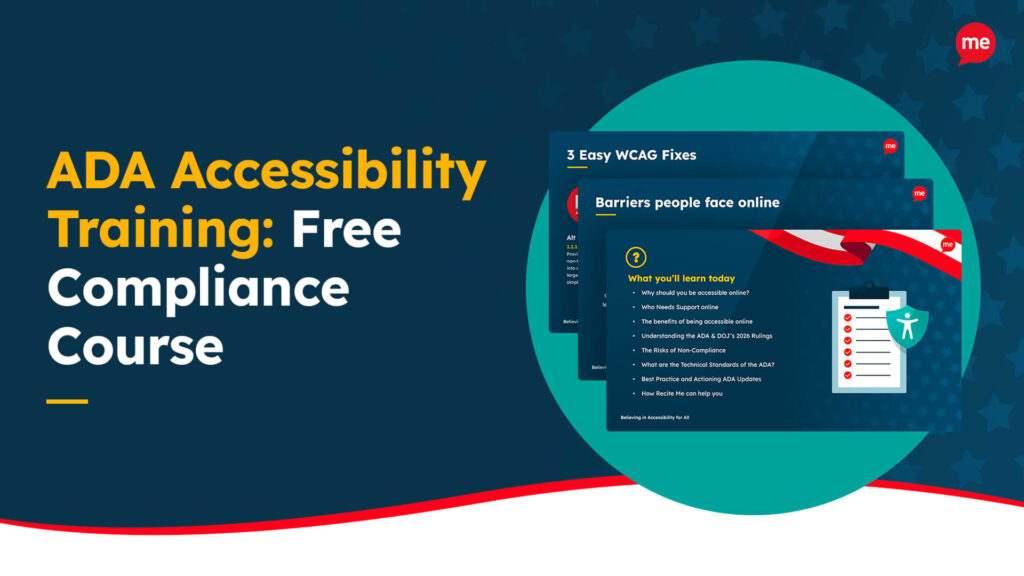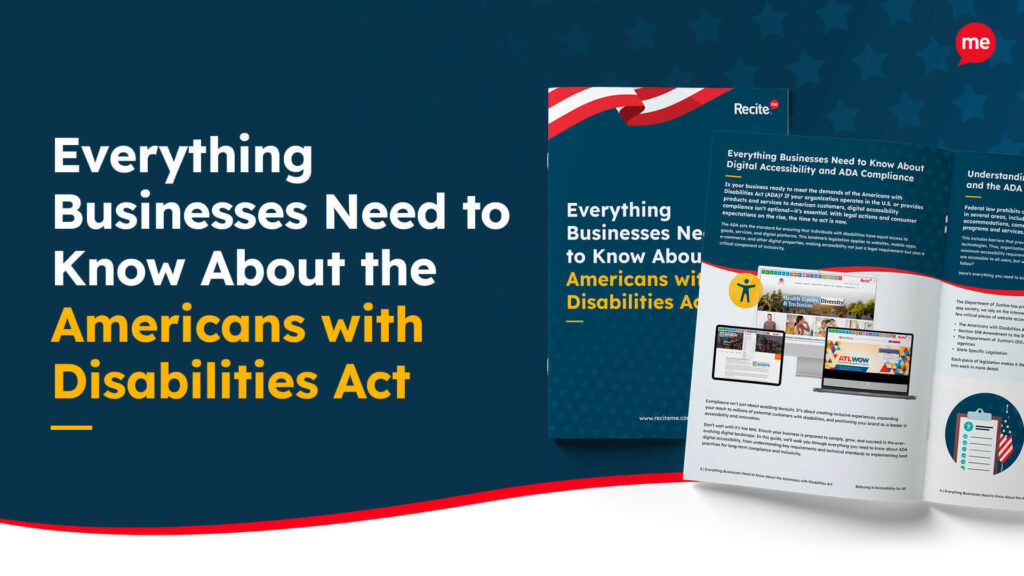Get A Free ADA Compliance Audit Of Your Website
Download NowMaking sure you’re on the right side of the law is important. There’s no question about that. But the Americans with Disabilities Act (ADA) transcends mere legal compliance. It’s proof of your commitment to an equal society, where disabled people have the same access to products and services as their non-disabled counterparts. Not only that, but it opens up a whole new world of business opportunities that you may not have been privy to otherwise. So, whether you own a bustling café in Chicago or a digital marketing firm in Springfield, this article is your blueprint for understanding the ADA in Illinois and implementing its guidelines for digital accessibility.
Understanding the Americans with Disabilities Act in Illinois
The Americans with Disabilities Act (ADA) is a landmark piece of legislation that was enacted in 1990. At its core, the law prohibits discrimination against individuals with disabilities by requiring organizations to make their products and services accessible.

To understand the ADA better, you have to know how it is structured. The ADA consists of 5 titles, each targeting a different aspect of accessibility. A summary of each title is outlined below:
- Title I: Focuses on employment rights, mandating that businesses with 15 or more employees provide equal opportunities to applicants and employees with disabilities.
- Title II: Covers public services and transportation, requiring state and local government entities to be accessible.
- Title III: Relates to the accessibility of ‘public accommodations’; an umbrella term, which includes any business that provides goods, services, or facilities to the general public. Importantly, digital accessibility falls under the scope of Title III.
- Title IV: Ensures accessible telecommunications for individuals with hearing or speech impairments.
- Title V: Includes miscellaneous provisions that support the overall goals of the act, such as protections for individuals who wish to assert their ADA rights.
In Illinois, as with all U.S. states, Title III holds particular relevance for businesses that have an online presence. This is because, although the ADA was conceived before the digital revolution, it has since been interpreted to cover things like websites and apps. Since websites and apps act as public digital offerings, if your digital platform isn’t accessible, you could be in violation of Title III of the ADA.
Want to make sure your website is compliant with the Americans with Disabilities Act? Then unlock the ADA compliance checklist now. Discover actionable steps to ensure ADA compliance, helping you avoid lawsuits and any other negative consequences of non-compliance.

Which businesses do the Illinois ADA guidelines apply to?
The ADA applies broadly, leaving room for few exceptions, but not all businesses are subject to the same requirements. Illinois-based businesses that fall into one of the following categories must comply with the ADA’s requirements:
- Businesses with 15 or more employees – Must, under Title I, ensure that qualified individuals with disabilities are not discriminated against in job applications, hiring, firing, promotions, training, benefits, etc.
- Public accommodations – This includes hotels, restaurants, retail stores, theaters, and even websites offering goods or services under Title III.
- State and local government entities – Required to ensure services, programs, and buildings are accessible under Title II.
Even if your business doesn’t directly fall under ADA mandates, adopting accessibility practices is still a smart idea. It demonstrates inclusivity and future-proofs you against potential lawsuits as your organization, and the laws regulating it, evolve.
Strategies to make your website ADA compliant in Illinois
Most modern businesses have some form of online presence. And with web accessibility related lawsuits reaching 2,281 in 2023 and the average website home page containing 50 accessibility errors, focusing your compliance efforts on digital accessibility is not a bad idea. This section details two essential strategies for keeping any Illinois-based website or mobile app ADA compliant.
Continuous accessibility testing
Regular accessibility testing for ADA forms the basis of any proactive approach to ADA compliance. It helps identify and fix accessibility gaps before they become major legal issues, safeguarding your business against fines and other implications.
There are 3 different testing methods you can employ: automated, manual, and user testing. For the best outcome and the most comprehensive coverage of accessibility issues, all 3 methods should be used in succession. Here are brief summaries of each:
- Automated – Software-based tools, like an accessibility checker, scan your website’s code for any glaring accessibility failures, synthesizing the results into a succinct report with actionable guidance.
- Manual – Web developers and accessibility experts evaluate your site’s usability to check for more nuanced design issues.
- User – Relies on existing users with disabilities to provide constructive feedback and first-hand insights on a more granular level than other testing methods, uncovering issues that are often overlooked by algorithms or non-disabled testers.

One frequently asked question when it comes to auditing is: “how often?”. The truth is, there is no right answer to this. However, it is generally accepted that the more regular you monitor accessibility, the better. At the very least, comprehensive tests should be conducted after every website change or regulation update.
Following the best practices of WCAG
Put simply, the Web Content Accessibility Guidelines (WCAG) are the gold standard for web accessibility. They are a set of requirements set out by the World Wide Web Consortium (W3C) on how to achieve different levels of digital accessibility. In other words, WCAG provides the roadmap for making accessibility improvements. So, once you’ve audited your site, consult the guidelines to see what your next steps are.

WCAG is based on 4 core principles, called POUR: perceivable, operable, understandable, and robust. From these principles, the W3C has prescribed specific requirements for 3 different levels of WCAG compliance — Level A, AA, and AAA — where each subsequent ‘A’ represents stricter compliance.
Although not explicitly outlined in the ADA, it is generally accepted that if you adhere to WCAG 2.1 Level AA, you are setting yourself up for avoiding any potential lawsuits that may have otherwise come your way. However, if time and resources allow, striving for Level AAA is the way to go, giving you complete peace of mind.
Consequences of not complying with ADA laws in Illinois state
Consider if a visually impaired customer attempts to use your website but cannot complete a purchase due to inaccessible design. Not only does this create frustration for the user, but it puts you at risk of facing legal action, among other things. Let’s unpack the risks of ADA non-compliance in a bit more detail.
Financial penalties
Failing to comply with the ADA’s stipulations can result in fines ranging from $75,000 for a first violation to $150,000 for subsequent offenses. An e-commerce store in Illinois, for example, that does not ensure screen-reader compatibility throughout its site, becomes susceptible to these sorts of penalties, especially if customers file a lawsuit. However, even an unsuccessful lawsuit can incur significant costs just from the legal process itself.
Legal expenses
Legal costs associated with ADA lawsuits can mount up quickly. These include attorney fees, court expenses, and potential settlements, which can add up to sums in the tens of thousands.


Reputational damage
Publicized lawsuits can severely harm a company’s image, especially in today’s social media-driven world, where news seems to travel fast. Boycotts and negative online reviews can lead to a huge churn in existing customers, while deterring potential new customers. Once public perceptions are set, they are very difficult to change, making growing your business 10 times harder than before.
Reduced customer base
Illinois-based businesses that fail to comply with the ADA risk alienating the state’s disabled population, which makes up approximately 24% of the state’s total population. This is a huge market segment with huge potential for increased sales. If an online retailer, for example, lacks appropriate keyboard navigability, shoppers with motor impairments may turn to more inclusive competitors. In this way, an inaccessible website not only reduces your customer base, but helps bolster that of your competitors.
Operational disruptions
If a lawsuit is filed against your business for failing to comply with the ADA, the resulting settlement agreement may require you to make forced business changes, such as significant adjustments to your website’s design. This can incur much higher costs than if you had taken a proactive approach to accessibility, as making retroactive adjustments, and doing so under settlement conditions, may cause you to temporarily close your business or delay operations.
Get a free automated ADA compliance audit of your website. This audit will highlight compliance violations and provide the recommendations needed to meet ADA compliance standards.

Significant Americans with Disabilities Act lawsuits in Illinois
There has seen several high-profile ADA lawsuits in Illinois, which highlights the importance of compliance. Let’s take a closer look at some of the main cases:

Sumaya Hussein v Balenciaga
In the case of Sumaya Hussein v Balenciaga, it was alleged that Balenciaga’s digital platforms failed to provide adequate accessibility for individuals with disabilities, breaching Title III of the ADA. Accessibility-related lawsuits like this emphasize the legal obligation of businesses to ensure their digital assets, including websites and mobile applications, are usable by everyone.
Many such lawsuits highlight the importance of compliance with WCAG, which provide a benchmark for ADA compliance. Illinois, like many other states, has seen a rise in such cases, showcasing the growing demand for digital inclusivity in all sectors
P.F. Chang’s China Bistro
The class-action lawsuit against P.F. Chang’s China Bistro alleged that the company violated the Americans with Disabilities Act (ADA) by failing to ensure its website was accessible to individuals with visual impairments. The complaint claimed that the website lacked compatibility with assistive technology, making it difficult or impossible for blind users to access essential features like browsing menus, making reservations, or ordering food online.

The lawsuit sought injunctive relief, which would require P.F. Chang’s to redesign its website to meet ADA compliance standards. This case underscores the importance of adhering to WCAG, which ensures digital platforms are compliant with ADA Title III.
Need more help becoming ADA compliant?
The following resources are packed full of actionable tips and expert advice for making your digital content compliant with the Americans with Disabilities Act:
Free ADA Accessibility Training
Take the first step to ADA compliance by completing our training course.
Free ADA Accessibility Guide
Ensure your organization is meeting the requirements for ADA compliance.






